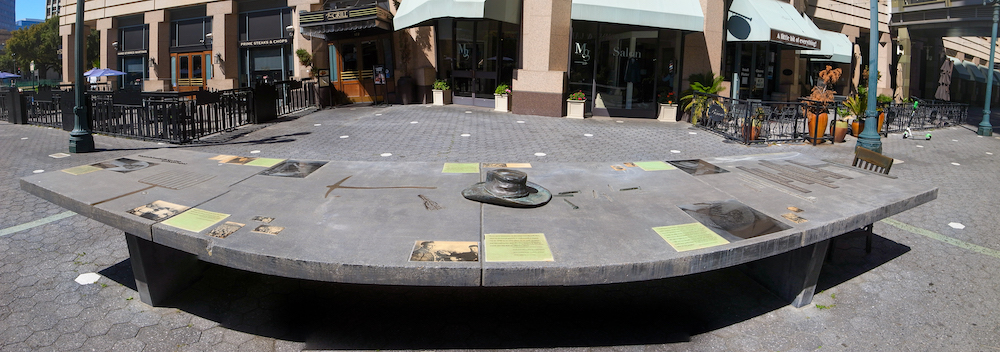Man of Fire

Photographer: Hunter Ridenour (2022)
Artist: Kim Yasuda
Year: 1998
Commissioned by: City of San José Public Art Program
Location
Contrast the feeling of strolling on activated paseos versus streets with vehicles. Paseo de San Antonio is one of the most used passages in downtown San Jose. The paseo serves as a focal point for dining, events and theater and is exemplified in the Man of Fire artwork. One way to promote more pedestrian experiences is to temporarily close streets to vehicles. Be sure to check out the annual VivaCalleSJ event which is a vibrant and fun community celebration that prioritizes walking and cycling over vehicular urban modality dominance.
Biography
There's so much about Galarza that's important, from his biographical book Barrio Boy, which is about a migrant boy from Jalisco who comes to the fields of California as a migrant worker, to his scholarship, his labor organizing, and in general his work organizing farm workers in an era of anti-communism, anti-unionism, and during the era of the bracero program, which he was an ardent critic. His work with the NFLU especially sits at this interesting intersection of scholar activism which has been chronicled in the new book In the Struggle: Scholars and the Fights Against Industrial Agriculture in California.
*Thank you to Professor Oliver Rosales, Professor of History, Bakersfield Community College, for the references to Dr. Galarza's life.
Aesthetics of Public Art
By Caitlin Pambid, Art 174, Fall 2021, SJSU
Kim Yasuda’s site-specific work honors Dr. Ernesto Galarza, a scholar, activist, community organizer and civic leader. The table is made of cast bronze and the objects on the table, such as a hat, book, and farm tools were created with inlaid bronze.
The large library table is the “centerpiece” of the work, and references Dr. Ernesto Galarza’s interests in academics and labor organizing.,The importance of family to Galarza is represented by the banquet size of the library table and the arrangement of the photos and texts. The single chair at the head of the table is bronze with a wooden seat facing west towards Cesar Chavez Plaza representing his balance as a field worker and scholar. Lesser known than the table and chair: there are paved Ribbons of Terrazzo, which have bronze texts in Spanish and English with personal notes about Dr. Galarza from family, friends, and colleagues.
(concludes Caitlin's essay)
Public Art as Resistance
“Man on Fire” captures the influence of place and the individual on each other. Dr. Galarza’s work was framed in the geography of the San Joaquin Valley and the division between white and Mexican farm workers. His work also transformed the place from one of division to cooperation that laid the groundwork for the introduction of Mexican history to the schools. “Man on Fire” resists the separation of place and the individual to show the symbiotic relationship at work and his role in the formation of both.
Wrapping Up Your Walk
The town-gown relationship between San José State University and the City of San José extends into the larger campus district. SJSU is not only re-envisioning the physical campus through a two year campus master planning process it will plan development for the main and south campuses and off-campus properties in connection with the City of San José through 2040. Efforts of the university to integrate outside its blocks are well underway. There is an urban Studio on the Street initiative, the Hammer Theatre, and the adjacent Camera theater mixed-use redevelopment project.
After you experience the history of the neighborhoods and the urban environment on our walking tour, you can visit all of the vibrant, rich downtown San José public artwork with maps from “Public Art San José Downtown,” including other public art initiatives Downtown Doors, Art Box Project San José, and Street Life.
Talk to Us!
Thank you for joining us on this walk. We look forward to hearing from you and recommend checking back often on the website to see other walking tours as more students, faculty, and artists' organizations collaborate.
We welcome your stories and your experiences from this walk. Please take a moment to provide us with some feedback by answering a few brief questions on this survey before you end your walking day.
#SJResistArt - Tell Us Your Story!
Did you remember to contribute your #SJResistArt Instagram post to our collection? Please add the hashtag and ensure that your post is public. Your Instagram post may be selected for our April 24 exhibit that precedes a discussion with some of the artists your saw today.
Join us for the panel and exhibit on April 24 - free and open to the public (registration required).
Additional Resources
- Description by City of San Jose
- In the Struggle: Scholars and the Fight against Industrial Agribusiness in California by Daniel J. O'Connell and Scott J. Peters